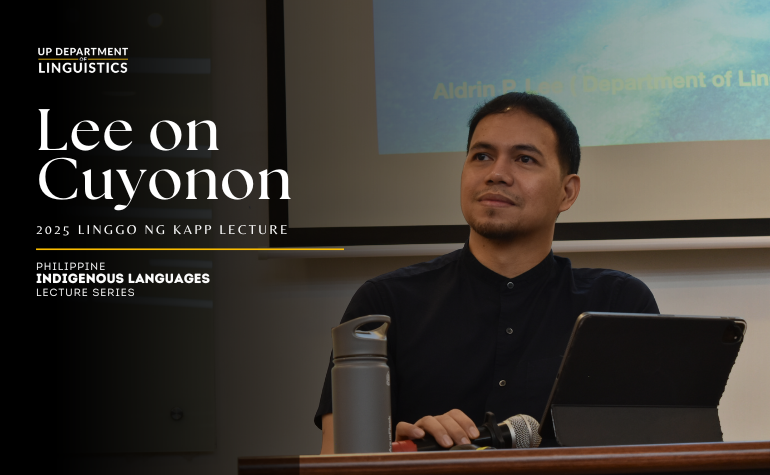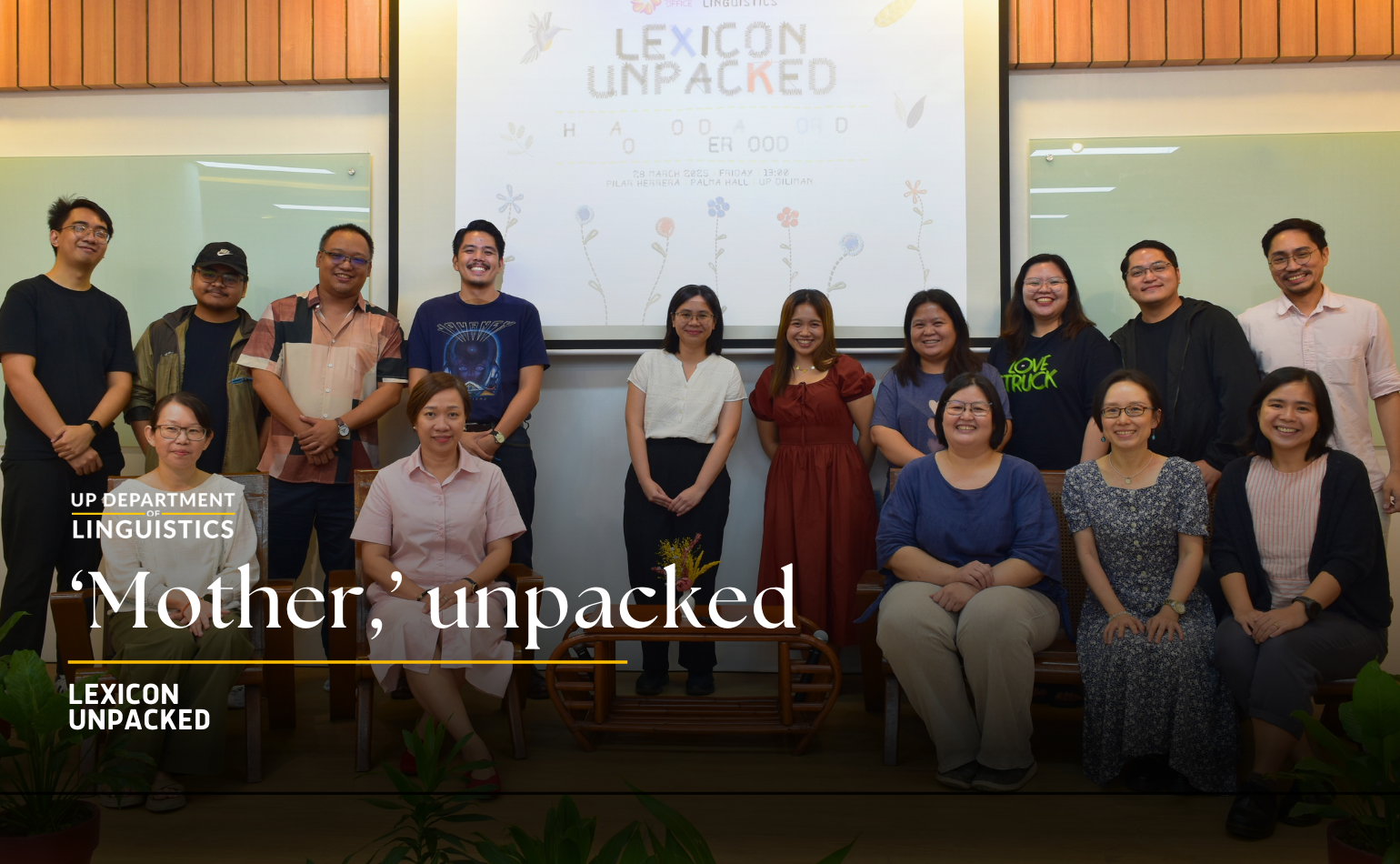
Words are not only labels within the lexicon as they also “reflect lived experiences, collective memory, and evolving identities.” In this year’s first installment of Lexicon Unpacked held last 28 March at the Pilar Herrera Hall, the UP Department of Linguistics organized a lecture to celebrate Women’s Month by unpacking ‘motherhood’ as understood in different cultural perspectives. With a focus on the Filipino ina, the Japanese okaasan, the Korean omoni, and the Thai mae, the lecture explored how these words are embedded in our collective lexicon.
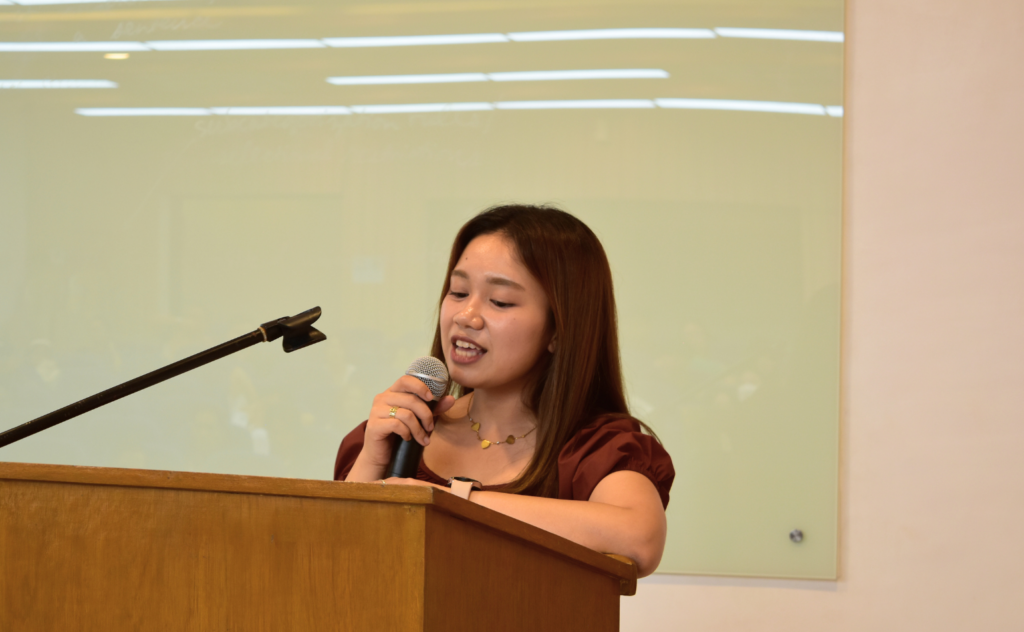
ina
Assoc. Prof. Mary Ann Bacolod’s presentation, “Unpacking Ina: The Concept of Mother and Motherhood in Filipino,” explored the different meanings associated with ina and the concepts and cultural values related to these meanings. Through ethnolexicography and text analysis, Bacolod examined the words to describe and define the terms babae and ina, categorized their semantic domains, and discussed the different types of meanings and their interpretations with the term ina. The lecture revealed that the dictionary focuses, in the basic physical sense, on the word ina, which is primarily defined by its biological function– a female parent or a woman who has given birth. The word babae is also defined in terms related to reproductive capacity.
Regarding its cultural and abstract usage, Filipinos have many symbols for ‘mother,’ reflecting mothers as more than just their biological function.ina takes on abstract and symbolic roles such as source, nurturer, and sustainer. These are reflected in the words Inang Kalikasan ‘Mother Nature’ and inang dulangan. Moreover, symbolisms like nation or homeland are also some of the symbolic meanings associated with mothers, as in Inang Bayan ‘motherland’ and inang lalawigan ‘mother province,’ which reflect a sense of identity and belongingness. Mothers are also viewed as a foundation or origin in the words: inang wika, inang kompanya, and inang selyula. There are also honorific or heroic connotations rooted with the word mother, manifested in the titles: Ina ng Himagsikan, Ina ng Katipunan, Ina ng Balintawak, Ina ng Biak na Bato, Ina ng Rebolusyong Pilipino, etc. Mothers are also seen as protectors, nurturers, and figures of authority. Ilaw ng Tahanan (light of the house) is one of the most famous titles given to mothers, as they are naturally the nurturers of the family.
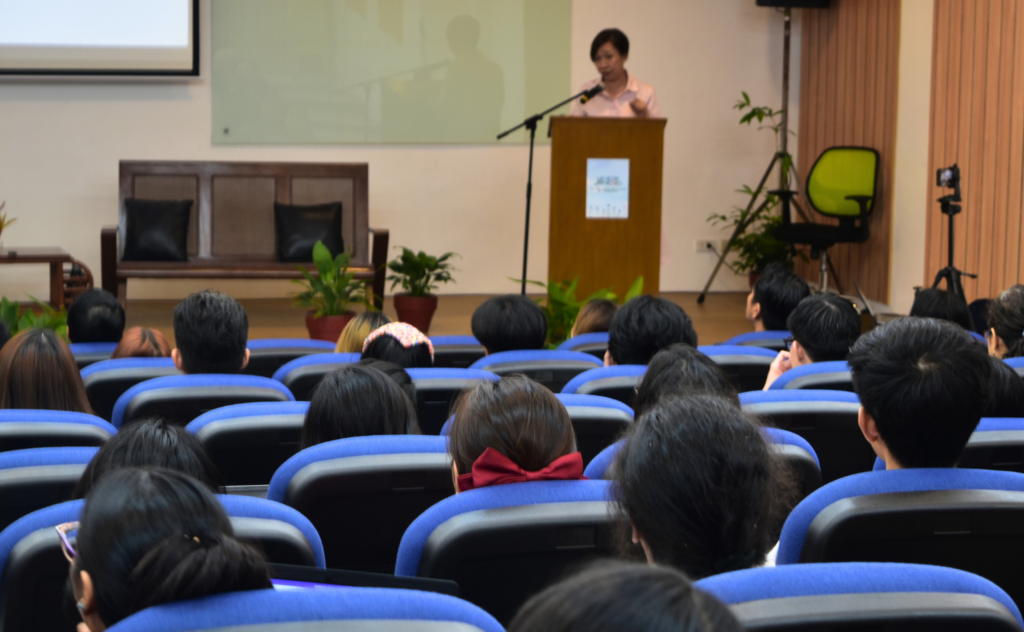
The ‘mother’ is also associated many times as a symbol of love, mercy, and human connection, as often seen in religious contexts: Ina ng laging saklolo, Ina ng Awa (Poblacion Muntinlupa), Ina ng mga Dukha (Diocese of Pasig), Ina ng Buhay (Novaliches), Ina ng mga Walang Mag-ampon (Marikina), Mahal na Ina ng Banal na Rosaryo ng Manaoag, Ina ng Pitong Hapis (Our Lady of Sorrows), Inang Sakdal Linis (Awit sa Nobena ng Ina ng Laging Saklolo), and many more. Through all these meanings, titles, and concepts, the word ina shows the values that Filipinos uphold. These values are centered on life-giving, guidance, protection, and love– often associated with mothers.
Bacolod also discussed the negative connotations for mothers, starting with the known derogatory word/expression p*tang ina, which is defined as a woman who left her family to be with someone else, and the expression inamo ka vovo, as often seen in social media.
In lexicographic analysis, the definition of ina is focused on its biological functions, such as reproduction, childbirth, and the ability to lay eggs, linking the concept of womanhood to their capacity to become mothers or giving birth. On the other hand, through the analysis of texts from corpora, the idea of motherhood extends to more symbolic portrayals, being figures of sacrifice, providers, protectors, givers of life, nurturers, etc.
Bacolod concluded her lecture with the Jewish proverbs saying, “One mother achieves more than a hundred teachers” and “God couldn’t be everywhere, so He created mothers.”
eomeoni
The second speaker, Asst. Prof. Fellow Kyung Min Bae, presented “K-Mother: Roots Discursive Meaning-making.” In her lecture, Bae examines how the Korean character for mo ⺟ (mother) appears in various compound words in Korean, which shows how motherhood is embedded in their language and culture.
어머니 (eomeoni) or 엄마 (eomma) are two of the most common words for mother in Korean. The Korean language has many other variations depending on their social status, family structure, and roles. The character ⺟ (mother) appears in words beyond its original meaning, varying according to the social classes and dialects. Historically, women’s roles were ranked according to their marital status and reproductive function. For example, there are different terminologies for the first wife or “main” mother, concubine, and stepmother.
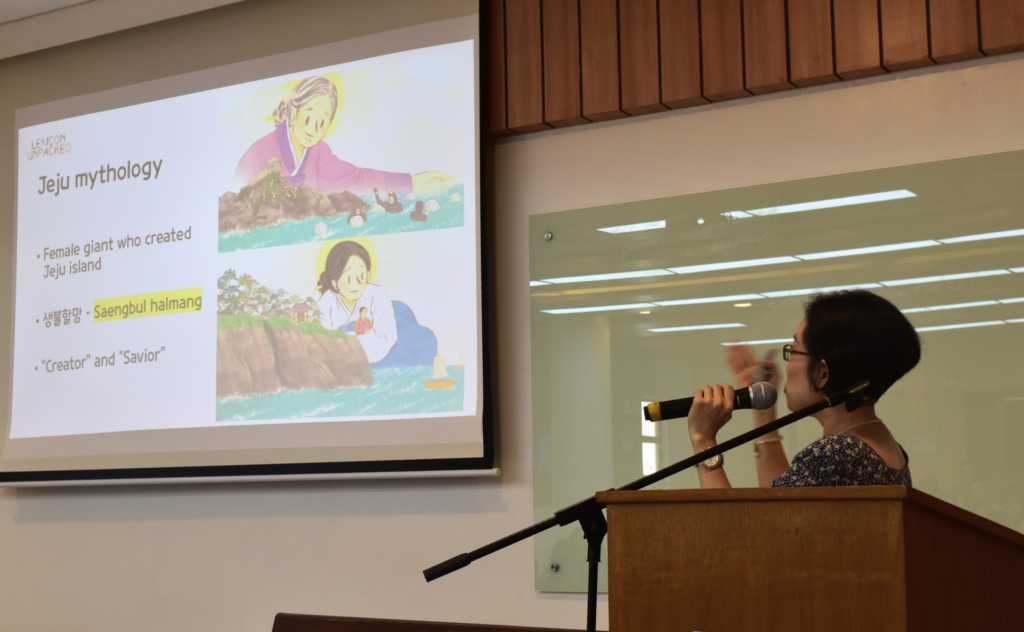
Bae also mentioned meanings associated with mother beyond its dictionary meanings. In social media, there is a term where they call mothers momchung, which translates to ‘parasite mother.’ ‘Parasite mother’ is a derogatory term to refer to housewives who are financially dependent on their husbands’ income and get public attention by doing unpleasant behaviors in public, such as the act of changing diapers. A public post birthed the term when a mother changed her child’s diaper in a restaurant that went viral. Mothers are culturally respected, but mothers in Korea are still subjected to pejorative judgment. Bae mentioned that it is ironic how mothers are expected to be motherly and caring and that their only role is caring for their children. Still, at the same time, they are expected to be financially independent or become full-time professional workers, or else they will be labeled as “useless citizens.” Because of these views and culture, new terms emerge to label mothers. It is also evident in public and online spaces wherein men call women degrading terms. “Social hatred and divisions in pejorative buzz words” emerge from these.
On a positive note, a term is also being referred to mothers as “hedgehog moms.” The term “hedgehog” is a metaphor for children with flaws. While hedgehog moms are referred to as someone who loves and embraces them despite these flaws. Additionally, Jeju mythology is associated with “mother,” which they call saengbul halmang, which means ‘creator’ or ‘savior.’ Korean literature also embraced feminist themes. The characters from this literature navigate romance, marriage, family, giving birth, child-rearing, and aging. The system also portrays women in all domains, including the economy, religion, politics, media, and education.
Bae ended her presentation with an open-ended question: “How are mothers ‘really’ seen in Korean society today?”
okaasan
Senior Lecturer Farah Cunanan discussed in her lecture “Okaasan Core: What it means to be a mother in Japanese.” There are many names for ‘mother’ in Japan, depending on the context of who you are talking to. The things to consider when referring to mothers or talking about mothers include: (1) in-group vs out-group addressee formality, (2) social status and time period, (3) closeness, gender, and age. This range of names shows how the roles of mothers differ according to formality, closeness, intimacy, and even geographical differences.
In Japanese, there are many ways to say “mother,” differing across various Japanese dialects.
- おが oga
- あっぱ appa
- おかあ okaa
- がが gaga
- かか kaka
- おかあま okaama
- おっかちゃ okkacha
- かかさ kakasa
- おかん okan
- おかか okaka
- おなん onan
- ばっち bacchi
- かくさん kakusan
- うっか ukka
- あんまー anma
The dictionary of meanings of words related to ‘mother’ or a female parent is also presented by Cunanan.
- 母子・ぼし mother and child
- 母性・ぼせい maternity or motherhood
- 母胎・ぼたい mother’s womb
- 母乳・ぼにゅう breast milk
- 祖母・そぼ grandmother
- 伯母・おば aunt
- 義母・ぎぼ mother-in-law
- 養母・ようぼ foster mother
In Japanese dictionaries, “mother” is defined as someone who gives birth and represents origin, foundation, and home. Many Japanese words are associated with mother as a home– something or someone you come home to:
- 母艦・ぼかん mother warship
- 母港・ぼこう home port
- 母船・ぼせん mother ship
- 母語・ぼご mother tongue
- 母校・ぼこう alma mater
- 母国・ぼこく home country
Through Japanese proverbs and idioms, the term “mother” extends to connotations of the foundation or basis of ‘success’ and the core or foundation of the invention. These are reflected in the proverb: 勤勉は成功の母・きんべんはせいこうのは は, which means ‘diligence is the mother of success.’ Other examples of proverbs that reflect this definition are 勤勉は成功の母・きんべんはせいこうのは は ‘failure is the mother of success’ and 必要は発明の母・ひつようははつめいのは は ‘necessity is the mother of invention’. Many Japanese proverbs show motherhood’s relatedness to care and nature, kindness, home and child-rearing, balance of kindness and sternness, role models, etc.
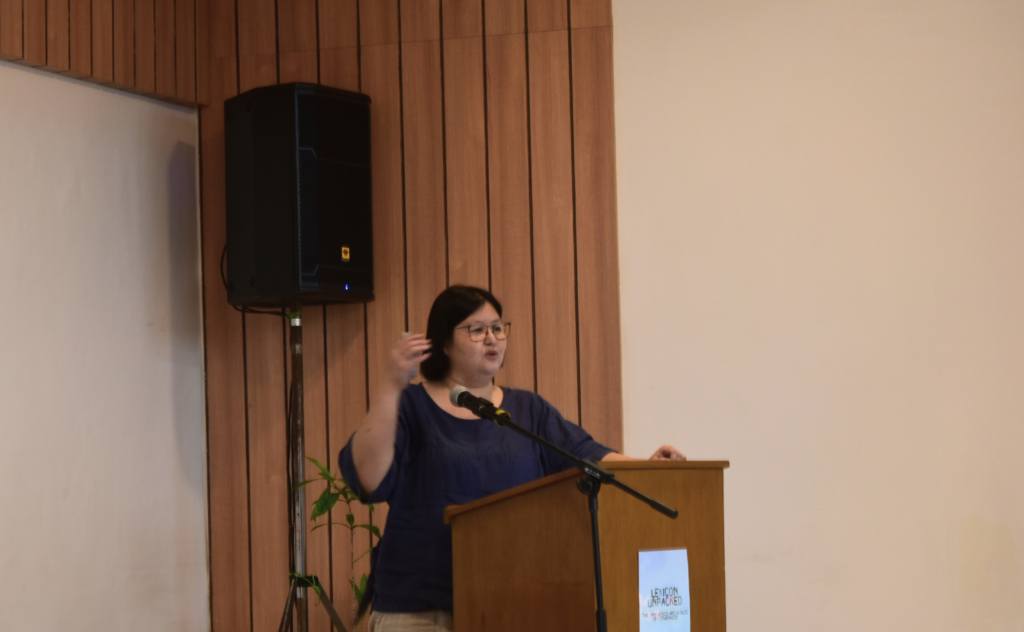
Japanese pop culture and its portrayals of mothers are also discussed in the lecture, including TV dramas and anime that often stereotype mothers. Mothers are portrayed as either selfless caregivers or overbearing “monster parents.” Furthermore, Cunanan also highlighted critiques of societal norms, exemplifying the mothers in Japanese pop culture, such as Sazae-san or Atashin’chi, revealing pressures that mothers face to conform to the “ideal” behavior that society imposes on them. The public attitude towards parenting is reflected in their language. Having a nurturing mother is respected, but at the same time, there are criticisms of overinvolvement or parental control of mothers.
In Japanese culture, ‘mother’ is a noun and a layered identity. Cunanan reiterated her lecture that even if idioms and proverbs express traditional beliefs and values, this does not necessarily mean they oppose modern views. Instead, these reflect how values continue to evolve, revealing more complex layers of relationships like motherhood, along with cultural changes.
mae
Finally, Asst. Prof. Fellow Kritsana D. Canilao also shared her presentation on “’Mae’ /mɛ̂ɛ/’แม’ in Thai Society,” focusing on how Thai society uses the word mae and its hierarchical structures and various discourses in society. Canilao delves into the contexts in which Thais use the term mae, the women’s roles, values, characteristics, and values that can be reflected through the use of mae lexicons, and how we can define Thai society through contextual applications of mae. Canilao used contextual analysis in discussing these.
Mae can mean biological mother (mae luang, mae yua). In this lecture, Canilao discusses more meanings of mae beyond ‘mother.’ Tracing back to the Sukhothai period (13th-15th century), the early usage of mae can be seen as one of Thailand’s earliest records in the King Ram Khamhaeng Inscription. Herein, the queen mother is named Nang Sueang and later referred to as Phra Mae-yaa (พระแม่ย่า) or ‘Royal Grandmother.’ Mae also has a national significance, as the word is also evident in Thai monarchs in how they refer to royal women. These honorifics are Mae Luang ‘Royal Mother’ and Mae Fa Luang ‘Queen Grandmother’.
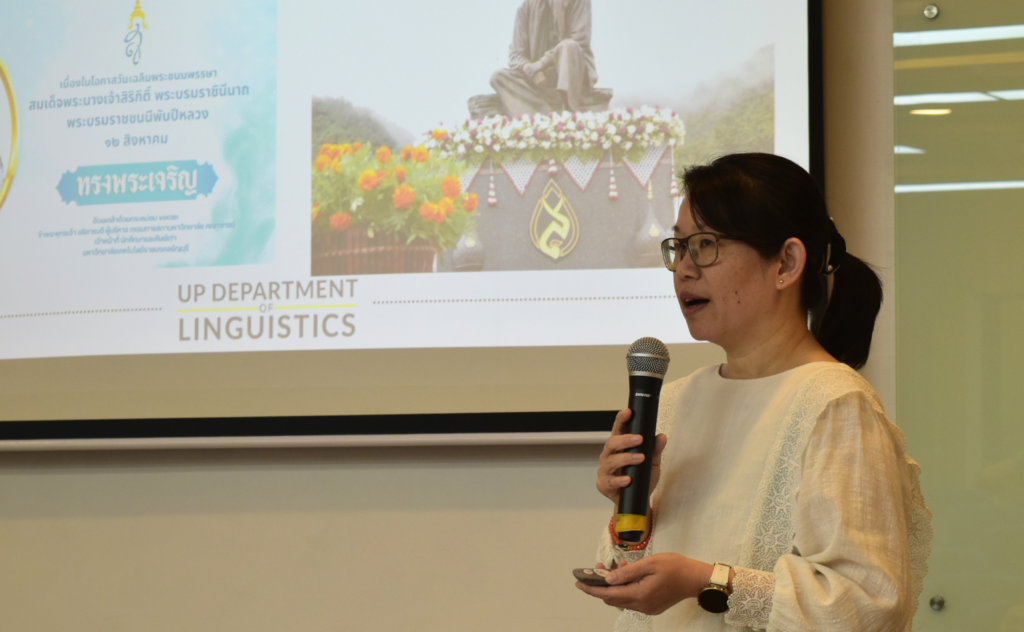
Mae can also refer to spiritual entities such as Mae Thoranii, goddess of earth, and Mae Khongkha, goddess of water. Mae is also a term tied to Buddhism and spirituality, such as Mae Chii (Buddhist nun) and Mae Phra (a kind woman). Moreover, mae can also be foundational objects (mae kunjae or lock) and leadership figures (mae thap or mae kong). In literature, women are called mae ying to refer to noble, well-mannered women who are calm, composed, morally upright, and skilled in tradition and religion. The Mae Ying portrayal aligns with Buddhist beliefs. The term mae extends to different domains, such as in domestic roles or service: mae baan ‘housekeeper,’ mae khrua ‘cook,’ and mae lao ‘head of prostitutes.’
In the digital age, mae also emerged as a Thai social media slang. Expressions like tua mae, tua mom, or tua maandaa refer to someone as ‘one of a kind.’ Mae Sri ruen, a common term also used in social media, refers to a “traditional Thai lady who is good at all household chores, including cooking,” as mentioned by Canilao. Canilao also shared that mae is now an all-gender word not necessarily used for females. It is now “for all” that even the LGBTQ+ community refers to themselves as mae. Day-to-day expressions and slang words are created as the word expands beyond motherhood.
Overall, Canilao examined how linguistic forms are shaped by the context surrounding them, considering their historical, cultural, and situational factors.
You can watch this year’s installment of Lexicon Unpacked on the Department’s Youtube Channel.
Published by Jenica Frances Estrellado

